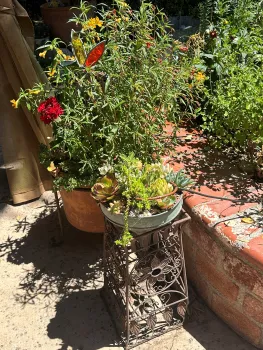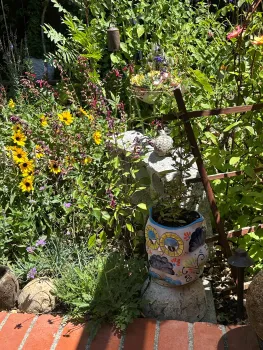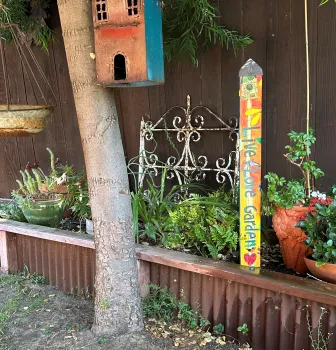
My garden is not very big, but I am an avid planter. How do I expand my gardening horizon? Pots! Pots let me plant in places where I can’t plant in the ground and provide visual interest to the garden. With a few containers, you can garden literally anywhere. If you are a renter, your pots are portable.
Where to start?
- Pick your spot. Decide where you want to place your container. Will it be in the sun, shade or a mix? This will determine your plant choices.
- Pick the right pot. The container needs to provide good drainage to prevent root rot. The size of the container needs to accommodate the mature plants (or multiple plants) and allow for root growth. Generally, a 10”-12” pot can hold 3-4 plants, a 14”-16” pot can hold 5-7 plants and a 16”-20” plant can hold 6-9 plants depending upon the size of the mature plants. Consider the weight of the planted pot if you will be needing to move it or put it on a stand with wheels.

A vintage washbasin and a whimsical ceramic pot provide dimension to the small planting bed. Photo: Dot Zanotti Ingels The material of your pot is important. Terracotta dries out more quickly but may be the look your going for. Glazed pots come in so many choices for design options. They breathe like terracotta but give you so many more options. Plastic pots retain more moisture and are lighter weight. Put holes in just about anything and it becomes a perfect pot. Vintage items can be repurposed for a fun choice. Anything you can drill drainage holes in can be an amazing and unique-to-you pot.
- Prepare the container by covering the hole with a coffee filter or mesh to keep the soil from washing out. If you are using a pot that was previously planted, make sure to give it a good clean first by removing any old debris and washing the pot with warm, soapy water and a brush. If you are concerned about disinfection, you can soak the pot in a 50% vinegar solution or a 10% solution of household bleach and water for thirty minutes. Rinse pots thoroughly and allow to dry completely before reusing.
- What you use to fill the pot is very important. Potting mix is a specialized growing medium for containers, while potting soil is a broader term for materials used to amend or replenish garden soil. Potting mix does not actually contain any soil. Instead, it is a blend of materials like peat moss, perlite, vermiculite, and coconut coir, providing good drainage and air circulation for happy roots. There are specialized soils for succulents and orchids. Not all potting soils are created equal, so do your homework. You can mix your own as well.

Now for the fun part. Fill your pot about 2/3 full of your mix and lay out your plants. Gently remove the plant from the nursery pot and gently loosen the root ball. Fill in around the new plants and lightly press on the mix to eliminate any air pockets. When you are happy with your results, water your new pot to help settle the soil. If needed, add more soil so that all the roots are covered but the soil level stays a couple inches below the rim of the pot. Keep checking in with your container to see when you need to water again. If the first inch or so is dry to the touch, give it a drink. A good way to make sure it is being given enough water is to check that some is running out of the drainage hole. If you are putting your plant in a saucer, make sure to keep it emptied. Plant roots do not like to sit in water and can rot. For easier maintenance, run irrigation from your garden system to your pots if possible.
Make it fun. You can easily change plants so go for it!
By Dot Zanotti Ingels, September 27, 2025

